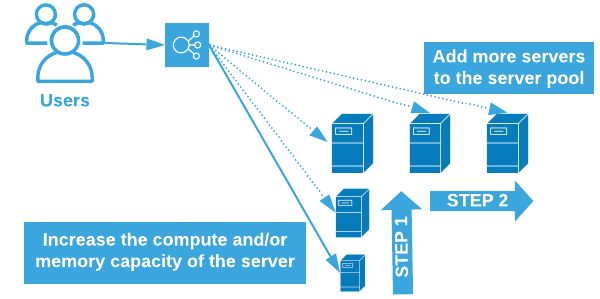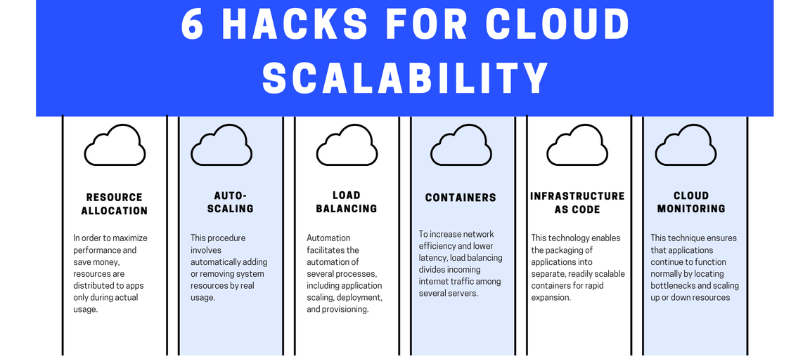Common Cloud Scaling Issues and How to Resolve Them
Cloud

Whether you are a small business or a large corporation, challenges in cloud scaling can seriously throw off your growth and efficiency. From unexpected traffic spikes to bottlenecks that affect the system’s performance, these issues can necessitate additional resources and drive up costs.
There are several common vertical and horizontal scaling problems that affect companies across the board. We put together the best hacks and most practical solutions to help your organization thrive in the cloud. With the right strategies and tools, companies can overcome these hurdles and harness the full potential of cloud scalability.
What is Cloud Scalability?
The capacity of cloud computing infrastructure to dynamically modify resources in response to shifting demand is known as cloud scalability. This implies that you don’t need to lay out money on expensive hardware upgrades or infrastructure modifications as your workload demands expand; you can easily adjust your virtual machines to allow for more cloud resources, storage, or bandwidth.
Cloud scaling offers several ways of ensuring optimal performance: enhanced flexibility, improved cost management, boosted performance, and heightened reliability.
As a result, you can significantly improve your IT infrastructure’s overall performance, streamline operations, and minimize downtime. By adapting quickly to demand fluctuations, cloud scaling empowers your business to operate more efficiently and respond effectively to market changes.
In brief, cloud scalability is a critical component of cloud computing and a necessary tool for every business trying to efficiently manage its computing resources.

There are 3 main types of cloud scalability: horizontal, vertical, and hybrid or diagonal scalability. Each of them offer unique benefits and fulfill different targeted business needs.
Horizontal Scaling
Scaling horizontally refers to the ability to add more instances of the same resource to the cloud environment. This type of scaling is often necessary to handle high volumes of web traffic or intensive data processing needs.
When you require additional computing power, with horizontal scaling, you can simply expand your environment by deploying more servers. One of the key benefits of horizontal scaling is its capacity to distribute workloads across multiple resources. This approach allows for seamless growth as your cloud computing demands increase, ensuring your existing infrastructure can keep pace with your business needs.
One of the primary concerns with horizontal scaling is the increased complexity of managing a larger number of instances. Coordinating and orchestrating these instances can be time-consuming and error-prone.
Additionally, as the number of instances grows due to your horizontal scaling efforts, network latency may also increase, potentially impacting application performance.
Ensuring data consistency across multiple instances can also be a challenge, especially in distributed applications. Finally, horizontal scaling can be expensive, as organizations need to pay for the computing power associated with each additional instance.
Vertical Scalability
This approach increases the existing resources of an individual instance. When you need more processing power, for example, you can upgrade the CPU, RAM, or storage of an existing server on your cloud management platform.
Vertical scaling is typically used for applications that require increased processing power within a single instance. One of the primary advantages of vertical scaling is its ability to optimize your physical hardware, increasing cost effectiveness and minimizing use of compute resources.
By boosting the capabilities of your current cloud infrastructure, vertical scaling allows you to meet growing demands without necessarily expanding your overall footprint.
While vertical scaling can be effective for certain workloads, it does come with some inherent challenges. One of the primary challenges is that there are often physical constraints to how much a single instance can be scaled. Eventually, even the most powerful hardware may reach its limits, making it difficult to further increase performance.
Additionally, vertical scaling can be expensive, as it often involves upgrading to more powerful hardware or instances, which can significantly increase costs.
Relying heavily on vertical scaling can increase vendor lock-in, as it may be difficult to migrate to a different cloud provider without significant costs or disruptions.
Diagonal Scaling
To create cloud elasticity, you can implement both vertical and horizonal scaling. With diagonal scaling, you can maximize the efficiency of your current resources while simultaneously adding new instances as needed. Complex applications that need a combination of cloud scalable resources like storage and bandwidth frequently use diagonal scalability.
Understanding the different types of scalable solutions is essential for selecting the approach that best aligns with your company’s needs while implementing cost savings from your cloud provider.
Whether you have additional workload demands, need increased storage capacity, or just could use more resources, third party cloud providers can often use diagonal scaling to help you reduce costs while achieving cloud scalability.
Benefits of Cloud Scalability
Cloud scalability offers many benefits for companies of all sizes, including:
Improved Performance
The scalability of the cloud enables you to instantly scale up or down resources, enabling you to react swiftly to changing demand for bandwidth or processing capacity.
Lower Costs
A third-party cloud provider can allow you to dynamically adjust resource allocation based on demand. This means you only pay for the resources you actually use.
For example, during peak periods, a capable cloud service provider can trigger automatic scaling, including scaling down idle resources to reduce cloud costs. This flexibility eliminates the need for upfront capital expenditures on hardware and infrastructure.
Greater Flexibility
Horizontal and vertical scaling enable you to react fast to evolving business requirements, putting you ahead of the competition. Also, cloud scalability will help you to adapt to market demands, by allocating resources according to customers’ need.

Increased Reliability
Manual scaling enables you to split up workloads among several resources, preventing downtime and guaranteeing the continuous availability of your services and apps. For mission-critical applications, which demand high availability and dependability, this can be particularly crucial.
Enhanced Security
Scalability in cloud computing enables you to put firewalls, disaster recovery, and other security mechanisms in place, which can help you shield your data on the public cloud from online attacks.
Issues with Cloud Scalability
Even with all of its advantages, setting up a cloud scaling system takes a lot of preparation and testing. Among the difficulties that could occur in horizontal and vertical scaling are:
- Resource bottlenecks: You can’t scale vertically if you run out of resources like CPU, memory, or disk space. Scaling in cloud computing effectively means choosing third-party cloud providers with the capacity to take your operations all the way to the top.
- Performance degradation: To ensure optimal performance, consider using instances with burstable performance capabilities for applications with intermittent workloads.
- Inefficient use of resources: Avoid this common issue by rightsizing instances, configuring your auto-scaling rules, and implementing cooldown periods to prevent overprovisioning during temporary spikes.
- Complexity: Due to the vast array of options, technologies, and best practices available, scalability may be hampered by system complexity in large enterprises with extensive infrastructures.
- Interoperability: Businesses that depend on numerous cloud providers may encounter difficulties due to the disparate approaches used by different providers.
- Disruptions to services: Systems that are not scale-optimized may experience performance issues that lead to service interruptions.
- Security: As an organization grows and shifts workloads, it may be more susceptible to cyber security breaches.
6 Hacks for the Best Cloud Scalability

There are a few hacks out there that you can use to improve performance, whether you have one existing instance or multiple servers. Here are our top tips on how to achieve optimal cloud scalability:
1. Resource Allocation
In order to maximize performance and save money, resources are distributed to apps only during actual usage. This distribution enables more effective vertical scaling and reduced cloud spend.
2. Auto-Scaling
This procedure involves automatically adding or removing resources by real-time usage without human intervention. Auto-scaling guarantees the system’s ability to scale several processes, including application scaling, deployment, and provisioning.
3. Load balancing
To increase network efficiency and lower latency, load balancing divides incoming internet traffic among several servers. This balancing maintains good performance levels and makes sure the server is controllable.
4. Containerization
This technology enables the packaging of applications into separate, readily scalable containers for rapid expansion. The software’s flexibility and scalability are improved by this containerization.
5. Infrastructure as Code (IaC)
Infrastructure as Code (IaC) allows developers to define and manage their infrastructure using declarative configuration files. With IaC, teams can quickly provision and scale applications by simply running a command, streamlining the deployment process and ensuring consistency across environments.
6. Cloud Monitoring
Your applications will run smoothly, even during peak traffic, with the proper monitoring. By identifying bottlenecks and adjusting resources through horizontal or vertical scaling, cloud monitoring guarantees optimal performance.
Conclusion
Vertical and horizontal scaling are crucial for ensuring cloud applications perform well and can handle increasing loads. By understanding these techniques and their benefits, you can make informed decisions to optimize your cloud elasticity.
Vertical scaling is perfect for applications that need powerful hardware or specialized computing. It involves upgrading existing instances, offering a simple and cost-effective solution for certain workloads.
Horizontal scaling is ideal for applications with unpredictable traffic or large-scale demands. It involves adding more instances to a cluster, providing flexibility and scalability but with added management complexity.
By carefully considering your application’s needs and using a combination of vertical and horizontal scaling, you can effectively address the challenges and achieve cloud scalability.
